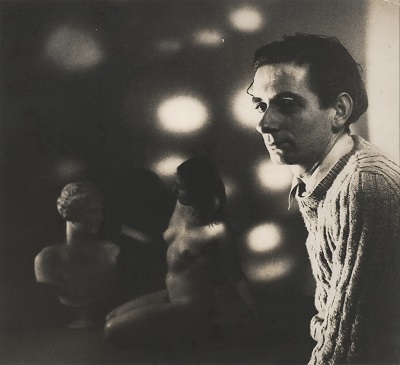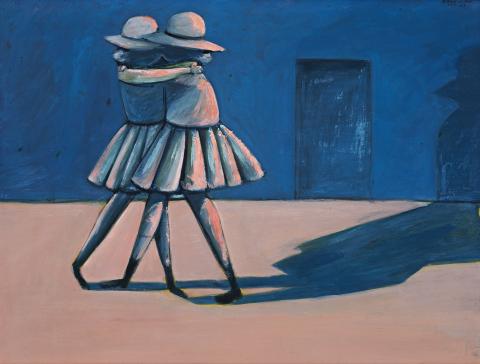THE FRIENDS, 1953
CHARLES BLACKMAN
tempera and enamel paint on pulpboard on composition board
57.0 x 75.5 cm
signed and dated upper right: BLACKMAN Feb 53
inscribed with title verso: THE FRIENDS / 14
Judith Wright McKinney, Queensland
Private collection, Melbourne
Sotheby’s, Melbourne, 30 April 2002, lot 9
Gould collection, Melbourne
Paintings and Drawings: Charles Blackman, Peter Bray Gallery, Melbourne, 12 May 1953, cat. 15
Autumn Exhibition 1977: Recent Acquisitions, Joseph Brown Gallery, Melbourne, 7 – 22 March 1977, cat. 69 (illus. in exhibition catalogue)
Charles Blackman: The Unknowable Divine Australia Felix, Benalla Easter Arts Festival, Victoria, 1995 (illus. in exhibition catalogue)
The Director’s Choice 2015, Celebrating 35 Years, Gould Galleries, Melbourne, 1 May – 13 June 2015, cat. 7 (illus. in exhibition catalogue)
Charles Blackman: Schoolgirls, Heide Museum of Modern Art, Melbourne, 4 March – 18 June 2017 (illus. in exhibition catalogue)
Ern Malley's Journal, vol. 1, no. 3, October 1953, p. 25 (illus.)
Mathew, R., Charles Blackman, Georgian House, Melbourne, 1965, p. 13 (as 'Two Friends')
City/Art, Heinemann Educational, Melbourne, 1978, p. 17 (illus.)
This work is included in the exhibition Charles Blackman: Schoolgirls, Heide Museum of Modern Art, Melbourne, 4 March – 18 June 2017
3. Frankland, Blackman, c.1950 - Lebovic.jpg

Charles Blackman was in his early twenties when he began the paintings and drawings that comprise the Schoolgirls series and while they are in part an expression of youthful anxieties – ‘[they] had a lot to do with fear, I think. A lot to do with my isolation as a person and my quite paranoid fears of loneliness …’1 – these compelling images marked a significant point in his career, bringing his work to the attention of the critics and broader public.
At the time Blackman lived in Hawthorn, an inner-eastern suburb of Melbourne, and it was here that he observed uniformed girls on their way to and from school, finding a subject without precedent that would form his first major series. The primary impetus for these works however came from his strong emotional response to the recent unsolved murder of Betty Shanks, a university friend of his wife Barbara’s, in Brisbane in 1952. Blackman also recalled stories of the notorious murder of a schoolgirl at the Eastern Market in Melbourne some thirty years earlier as having had a profound effect on him and his image of childhood.2 It is the underlying sense of menace and potential threat from an unseen, unknown source that pervades the series and through which it achieves its timeless psychological power.
Blackman knew the poetry of John Shaw Neilson through his wife and her friend, the poet (and first owner of the present work) Judith Wright. It was however Sunday Reed who, after seeing some of the first schoolgirl paintings, introduced him to poems that seemed to Blackman to be ‘full of kinship; the sort of thing I was painting fitted in with it perfectly.’3 Setting the scene, a stanza from Neilson’s evocative Schoolgirls Hastening was reproduced in the list of works that accompanied the first exhibition of the series in 1953.
The exhibition at Peter Bray Gallery, Melbourne, was Blackman’s first solo presentation in a commercial gallery and The Friends, 1953 was one of fifteen paintings shown alongside related drawings and lithographs. With its dramatic contrast of light and dark shadow, limited colour palette, dynamic composition and sparse pictorial detail, The Friends has all the hallmarks of the best paintings in the series. Two schoolgirls are depicted in a tight embrace, the rhythmic pattern of their pleated skirts contrasting with the staccato depiction of their legs. The shadow cast by the two schoolgirls merges into a single united form and leads the eye to the only other detail in the picture, a dark doorway that beckons with a strong sense of foreboding. Reviewing the exhibition Alan McCulloch enthused, ‘In Blackman’s hands … Neilson’s schoolgirl becomes a creature of endless aesthetic possibilities … this young artist has created a series of paintings which are at once exciting and extremely stimulating.’4 While there was no consensus of critical opinion about the exhibition at the time, Blackman’s Schoolgirls are now regarded as one of the most significant groups of modern works produced in Australia during the immediate post-war years.
1. Blackman, C., quoted in Shapcott, T., Charles Blackman, André Deutsch, London, 1989, p. 11
2. See Moore, F. St. J., Charles Blackman: Schoolgirls and Angels (exhibition catalogue), National Gallery of Victoria, Melbourne, p. 38
3. Blackman, C., quoted in Shapcott, op. cit.
4. McCulloch, A., ‘Quantity – and Quality’, The Herald, Melbourne, 12 May 1953
KIRSTY GRANT
FORMER DIRECTOR OF HEIDE MUSEUM OF MODERN ART,
FORMER SENIOR CURATOR, NATIONAL GALLERY OF VICTORIA
